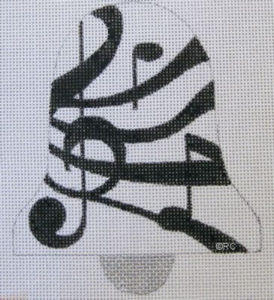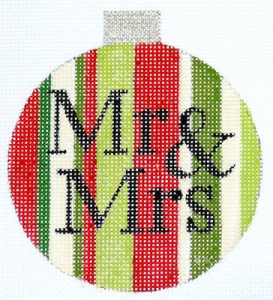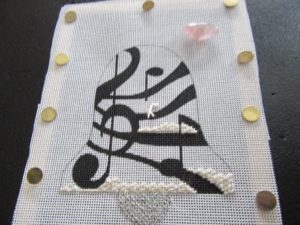
A canvas such as this Raymond Crawford bell looks like it will make great needlepoint with its contrasting colors and bold modern style. And indeed it will — if only your can figure out what to do with the background.
The background is broken up into sections with broad curving lines. They make the piece look great but can I make a textured stitch work for the background?
I admit my first thoughts were that I was going to be limited to Tent Stitch or variations of it where counting was not necessary.That put me off stitching this for some time because with a pretty silk and metal thread and black as the only color, I wanted something more striking.
Stitch Construction & Choice
As I stitched the silver clapper I thought about what stitches could work here. The design isn’t fussy and the areas of background are relatively large so most stitches will fit. The horizontal lines make a strong visual statement so any stitch that has a vertical or diagonal direction will fight with them and should be avoided.
That left me with stitches that were non-directional or that had a horizontal direction. I quickly discarded horizontal stitches because I decided that the last thing I needed to add were more lines.
There are plenty of non-directional stitches out there to consider, so I needed to narrow down my selection. Because my thread is off-white I needed a stitch with full coverage so the whiter canvas wouldn’t show. That eliminated stitches such as Woven Plait that allow the canvas to show.
I also quickly realized that, for me at least, the stitch had to be one I could make in horizontal rows. I felt that the background areas wouldn’t let me really get going if I was stitching diagonal rows.
I decided on a Nobuko Stitch because it is done in horizontal rows, covers completely, and is non-directional. As a bonus, it’s easy to set up the bottom or top rows of areas.
Guidelines for Interrupted Backgrounds
Your canvas will be different from mine, but these guidelines will help you pick and stitch these backgrounds well.
- Pick a stitch that is non-directional.
- The stitch should be one that can be made in vertical or horizontal rows.
- Stitch the background first because it will be easier to place areas if there is no stitching interfering.
The Counting Method of Background Stitching
The traditional and best way to move from area to area is to count so that the background in the new area is continuous with the background in other areas. This is essentially what you do when the focal point is in the center of a background. You want the design elements to look as if they are floating in front of a pattern. The stripes of Raymond’s Mr & Mrs, below, do just that.

I counted (2 short-2 long) along the bottom of the bell and wherever the interruption was vertical. I am able to count that because the break interrupts the row as I am stitching it. You can do this where there is an actual break (right side) or where the area to be stitched is too narrow for full stitches (left side). The picture below shows this on the bell.

If you are stitching something that will be submitted to a needlework show for judging always do this. Judges mark off points when the background doesn’t match when counted.
The Non-counting Method of Background Stitching

A far easier way to deal with the interruption problem is to start each section on its own, as if you were starting a new canvas. This means that areas that don’t meet may or may not match up. Because the interruptions completely isolate areas, you can do this without it looking odd.
In this project the strong color and value contrast will make it harder to see if the patterns do match up.
If you choose to take this approach you can only use it in areas that do not meet at all. If they meet, even if they are stitched in different colors the patterns must be continuous. To start a new area, just begin kit as you would begin this stitch on a new canvas. The top background area in the picture above (third from the bottom) was started this way. I will use the same method for the top two areas of background.
About Janet M Perry
Janet Perry is the Internet's leading authority on needlepoint. She designs, teaches and writes, getting raves from her fans for her innovative techniques, extensive knowledge and generous teaching style. A leading writer of stitch guides, she blogs here and lives on an island in the northeast corner of the SF Bay with her family

Is this piece still available for purchase, Janet? TIA
Yes, it is from Raymond Crawford and can be ordered by any needlepoint shop. He also has music ornaments like this in other colors and shapes.
Keep stitching,
Janet